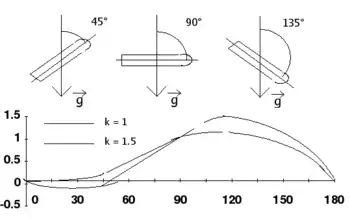Prolonged sine
The law of the prolonged sine was observed when measuring strength of the reaction of the plant stems and roots in response to turning from their usual vertical orientation. Such organisms maintained their usual vertical growth, and, if turned, start bending back toward the vertical. The prolonged sine law was observed when measuring the dependence of the bending speed from the angle of reorientation.

The observed law
It was observed that deviation from the desired growth direction by more than the 90 degrees causes further increase of the bending speed. After turning the 135 degrees the reoriented plant or fungi understands that it is placed "head down" and bends faster than turned by just 45 degrees. Poul Larsen in 1962 [1][2] proposed, that the intensity of the gravitropic reaction (bending rate) is proportional to
where α is the angle of reorientation, g - gravity vector and constants a and b are determined experimentally. [3]
Significance
Following the popular hypothesis of the mechanism of the plant spatial orientation, the bending from the horizontal position is caused by some small heavy particles that after turning put the pressure on the side cell (statocyte) wall, irritating some system and activating the bending process. The pressure of such particle to the cell was would be proportional to the sine of the reorientation angle, being maximal at 90° reorientation. It would be equal for the reorientations by both 45° and 135°. The prolonged sine law concludes that there are very significant deviations from such a predicted reaction.
References
- Larsen P, (1962), Ortho-geotropism in shoots and coleoptiles, in Encyclopedia of plant physiology, W. Ruhland ed., Springer, Berlin, pp. 153-199.
- Larsen P, (1969), The optimum angle of geotropic stimulation and its relation to the starch statolith hypothesis, Physiologia Plantarum, vol. 22, pp. 469-488.
- Сила тяжести в процессах роста растений / А. И. Меркис; Отв. ред. Г.Б. Максимов. - М. : Наука, 1990. - 185 с. : ил., граф., табл. - Библиогр.: с. 169-184. - ISBN 5-02-004731-7